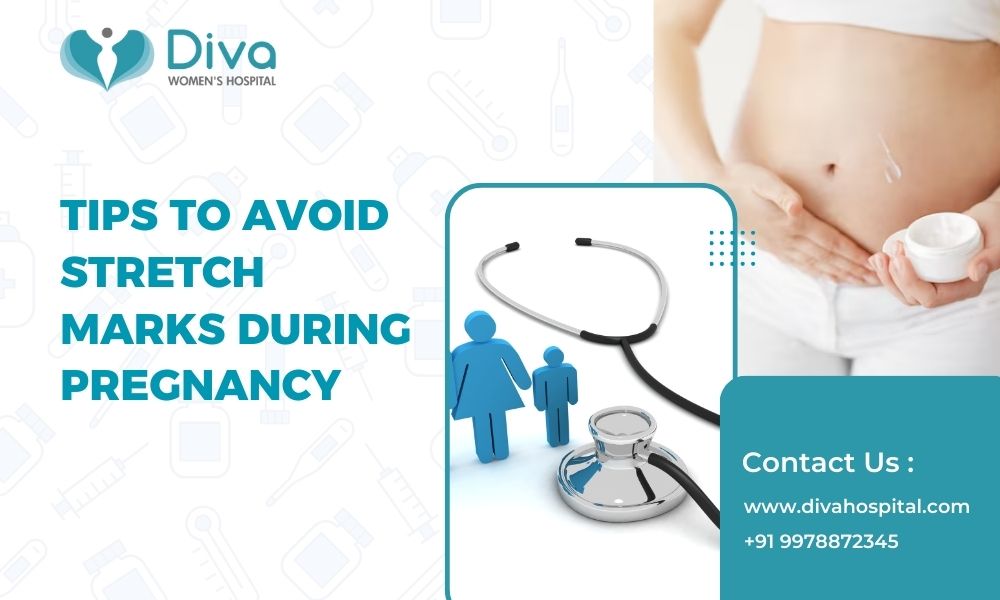Though pregnancy is a fantastic journey, there are several physical changes that happen during this period, including possible stretch marks. Many expectant mothers worry about these blems as the skin stretches to accommodate the growing baby. Although stretch marks are natural, they can be minimized or even avoided with the right lifestyle and maintenance.
Diva Women’s Hospital understands how important it is to be comfortable and confident all through pregnancy. This is why we have created this simple guide with doable recommendations to help you reduce the visibility of stretch marks during pregnancy.
What Causes Stretch Marks in Pregnancy?
Pregnancy causes stretch marks from fast skin expansion and hormonal changes altering the flexibility of the skin. Stretch marks most usually show in the following areas:
- Abdomen: The baby’s abdominal skin extends noticeably as she develops.
- Breasts: Milk generation and hormonal fluctuations affect them.
- Thighs, hips, and buttocks: These areas store fat to support pregnancy.
Stretch marks can arise from elements including genetics, fast weight increase, and lack of skin moisture. Still, you can keep your skin’s suppleness and reduce their frequency by using the correct preventative treatments.
Top Tips to Prevent Stretch Marks in Pregnancy
1. Keep Your Skin Hydrated
Less likely to tear and more elastic is moistened skin. While using encouraging lotions or oils outside can increase elasticity, drinking lots of water helps retain skin hydration from the inside.
- Get at least 8–10 glasses of water every day.
- To maintain soft and flexible skin, use vitamin E oil, shea butter, or cocoa butter.
- Steer clear of sugary beverages and coffee, which can dry out skin.
2. Eat a Nutrient-Rich Diet
Stretch marks in pregnancy can be avoided in great part by a good diet. Foods high in minerals and vitamins help to strengthen the structure of the skin and increase collagen generation.
- Vitamin C (strawberries and citrus fruits) increases collagen and skin healing.
- Vitamin E from nuts, seeds, and spinach keeps skin moisturised and nourished.
- Zinc (lentils, pumpkin seeds) promotes suppleness and skin repair.
- Salmon and flaxseeds’ omega-3 fatty acids help to increase skin elasticity and moisture.
3. Control Weight Gain
Steady weight gain lowers the pregnancy risk of stretch marks. Unexpected weight increases promote quick stretching that results in more noticeable and deeper markings.
- Eat a balanced pregnancy diet to prevent too rapid weight gain.
- Work on prenatal workouts, which include swimming, yoga, or walking.
- See your doctor for a pregnancy-stage-based healthy weight gain schedule.
4. Use Stretch Mark Creams & Oils
Using lotions or oils meant to stop stretch marks during pregnancy helps to maintain the skin healthy and strong.
- Search for lotions boosting elastin, collagen, and hyaluronic acid.
- Daily treat your breasts, thighs, and abdomen with almond oil, coconut oil, or bio-oil.
- Circular massages help blood flow and absorption.
5. Stay Active & Exercise Regularly
Mild to moderate exercise can assist in increasing blood circulation and skin flexibility, so lowering the pregnancy stretch mark risk.
- Increase flexibility with prenatal yoga.
- Work on light strength to keep muscle tone.
- Boost circulation with daily quick walks.
Frequent activity maintains the body toned and helps to avoid too much skin stretching.
6. Wear Comfortable Clothing
Tight clothes can limit blood flow and cause skin irritation, which might help to explain why stretch marks in pregnancy are more obvious.
- Go for flexible, airy pregnancy clothes.
- Steer clear of clothes that leave deep marks or compress expanding areas.
- Additionally useful in gently supporting the growing belly are maternity support belts.
7. Take Collagen-Boosting Supplements
Maintaining skin suppleness depends on the vital protein collagen. Following advice from your doctor, using collagen supplements during pregnancy will help the structure of the skin be strengthened.
- Collagen peptides found in food or supplements can stop skin deterioration.
- Foods heavy in gelatin, such as bone broth, boost collagen synthesis.
8. Dry Brushing for Skin Stimulation
By helping exfoliate dead skin cells and boost circulation, dry brushing can encourage new cell growth and lower the risk of stretch marks during pregnancy.
- Before bathing, soften-bristle dry brushes.
- To inspire skin regeneration, brush in upward, circular motions.
- For optimal effects, follow with a moisturising moisturiser.
9. Get Enough Sleep
Rest and recovery allow your skin to regenerate. Lack of sleep can reduce skin elasticity and make stretch marks in pregnancy more prominent.
- Aim for 7-9 hours of sleep daily.
- Sleep with a pregnancy pillow for added comfort.
- Practice stress-relieving activities like meditation to promote relaxation.
10. Stay Consistent with Your Skincare Routine
In pregnancy, avoiding stretch marks calls for constancy. Starting early and following a skincare regimen can really help.
- Every day, use oils and moisturisers.
- Keep nourishment and hydration.
- Keep up modest workouts to help skin flexibility.
Starting these preventive steps early on can help you to guarantee that your skin remains healthy during pregnancy.
While stretch marks in pregnancy are common, they can be minimised with proper skincare, hydration, and lifestyle choices. At Diva Women’s Hospital, we prioritise the well-being of expecting mothers by providing expert guidance on pregnancy skincare and overall health.
By following these simple yet effective tips, you can keep your skin healthy and maintain its elasticity throughout your pregnancy journey.

